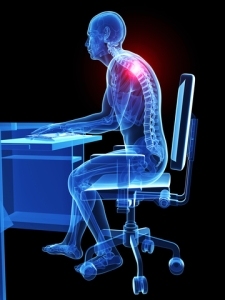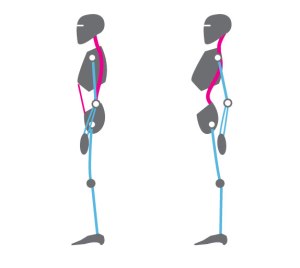
What is the deal with these weird looking figures? Why are they proportioned the way they are? Why the giant hands? And the oversized mouths? And what does it have to do with our brain? Lets investigate…
These figures are called the Sensory and Motor Homonculus Men. They are proportioned like this to illustrate how much of the sensory cortex and the motor cortex is devoted to sensing and moving the different areas of the body. So the hands and mouth are oversized because large areas of the brain are given over to operating the hands and mouth.
The Sensory Motor Cortex (below) is the part of your brain that deals with sensing (sensory) and moving (motor) your muscles.
Different areas of the sensory motor cortex are responsible for sensing and moving different parts of your body. The diagram below is called a sensory motor homunculus, it maps out which parts of the sensory motor cortex sense and move which body parts. The sensory homunculus (blue) receives information from the muscles regarding muscle tension/length, joint angles, load etc. The motor homunculus (red) sends motor commands back to the relevant muscles based on the aforementioned sensory information.

The commands from the motor cortex are a signal to the muscles to either increase the level of tension (contract), reduce the level of tension (relax) or maintain the level of tension. This back and forth of information, from the brain to the muscles, creates a sensory motor feedback loop. Sensory input arrives from the muscles into the sensory cortex > motor impluses exits the motor cortex and go back to the muscles > sensory input in > motor impulses out… and round and round it goes.
As you can see from the image above, your hands and face/mouth/tongue take up a huge part of both the sensory cortex and the motor cortex. Physically they may be small but neurologically they are massive. This makes sense when you begin to consider a) the many, many ways which we can use our hands and the very fine control we have over them and b) the fine control of the mouth, tongue and larynx that is required to speak.
Handwriting for example, requires a huge amount of brain processing power to be executed correctly. Perhaps that is why learning to write is such a laborious process. Writing, drawing, painting, playing an instrument, carving, pottery, sculpting all these activites require great skill and sensorimotor control of the hands. So to do any sort of fine work with the hands is to use and stimulate large portions of the sensory motor cortex of the brain. This suggests that the old saying “to be good with your hands” should maybe be understood as “to be good with your brain.” A point that is well illustrated in this interesting article that asks “Why does writing make us smarter?”
Interestingly the advent of computers, smartphones and touch screens has led to a sharp decline in real world hands-on skills being practiced. Now we seem to do everything virtually, on a computer screen. We have begun to use our hands mostly to tap keys and swipe screens, and in doing so we have reduced somewhat, the amount of stimulation that the sensory motor cortex receives. If we are not using our hands to their full potential, then maybe we are not using our brains to their full potential. I wonder what the long term implications of this will be on us and our society? As the old saying goes “Use it or lose it”. Only time will tell.
But for now let’s get back to the sensory motor cortex. As noted previously, another very large portion, approximately one third of the sensory motor cortex, is devoted to the sensing and controlling of the face, mouth, lips, tongue and larynx. Again this makes sense when we consider that as humans we speak. Speech requires a great deal of brain power to orchestrate. The lips, tongue and larnyx have to coordinate with our diaphragm in order to deliver intelligible speech or in a further refinement, to sing.
So with one third of the sensory motor cortex dedicated to the hands and another one third of the sensory motor cortex dedicated to the face/mouth/lips/tongue/larynx, there is only one third left. Just one single third of your sensory motor cortex devoted to the largest parts of the body! Your trunk, spine, hips, shoulders and limbs.
That is comparatively a very small section of the sensory motor cortex that is responsible for sensing and moving a very large area of the body. Is it any wonder then, that the areas of our bodies that have the least cortical (brain) representation are the same areas that are most susceptible to movement deficits and muscular pain? Back pain, hip pain, shoulder pain anyone?
The trunk, hips, shoulders, and neck are supported by a very small section of the cortex. This means less processing power for a large area of the body. This being the case it would make sense that we might have to spend a little more time maintaining our brains control over these parts of our body, making sure the modest amount of the sensory motor cortex that is apportioned to these areas is stimulated regularly.
Movement of all and any kind provides massive amounts of stimulation and sensory information to the brain. We traditionally think of information as purely intellectual, words, numbers, facts, data etc. But for your sensory motor cortex, MOVEMENT IS INFORMATION. And the more information your brain has about your body, the better you can sense and organise your movement.
So how can we help ourselves in this regard? A Somatic movement practice is a great place to start. Practicing somatic movements slowly and smoothly allows us to re-establish, maintain and refine our sensory awareness and our motor control. By relearning how to move our trunk and spine comfortably through their normal and natural ranges of motion. Then when basic control has been re-established, we can get on with enjoying our favourite acvtivities whatever they may be. (Running, walking, lifting, climbing, dancing, yoga, gardening, tennis, the options are endless).
You can start learning how to do all this right now by checking out the Learn Somatics YouTube Channel. If you’d like some help with a particular movement or muscular pain I offer online 1-1s via Zoom. No matter where you are in the world, it’s never been easier to Learn Somatics. So take advantage today.
As always thanks for reading.








